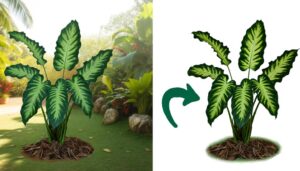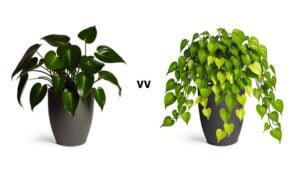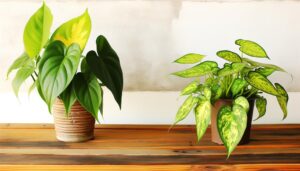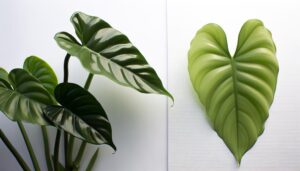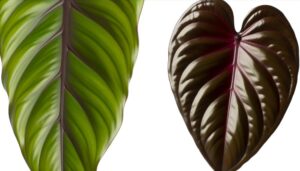Philodendron Imperial Green Vs Moonlight: A Guide!
Philodendron Imperial Green and Moonlight, both within the Araceae family, display distinct morphological and physiological traits. Imperial Green, native to Central and South America, features broad, dark green lanceolate leaves, excelling in high humidity and low-light conditions.
In contrast, the hybrid Moonlight exhibits bright lime-green, ovate leaves, flourishing in bright, indirect light.
The dense chlorophyll concentration in Imperial Green optimizes photosynthesis under dim conditions, while Moonlight’s carotenoid pigments enhance its vibrant coloration.
Both species benefit from well-aerated soil and high humidity. Each plant’s specific growth requirements and aesthetic appeal offer unique benefits, inviting further exploration into their cultivation nuances.
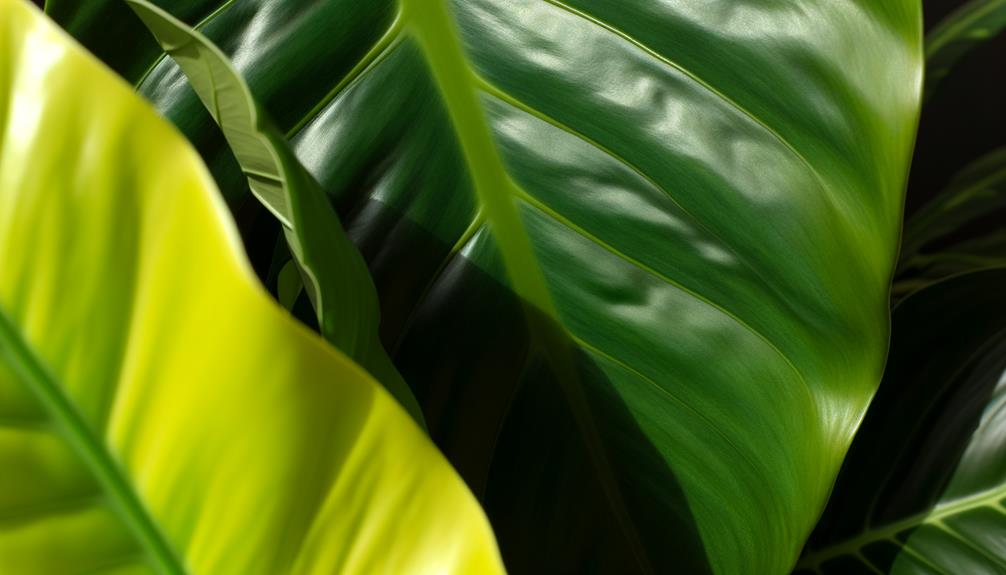
Key Takeaways
- Imperial Green has dark, heart-shaped leaves; Moonlight features lime-green, elongated leaves.
- Imperial Green thrives in shaded, high-humidity environments; Moonlight adapts to various indoor conditions.
- Moonlight’s foliage is bright due to carotenoid pigments; Imperial Green’s leaves have a higher chlorophyll density.
- Imperial Green handles low light well; Moonlight needs bright, indirect light for best coloration.
- Both plants prefer soil with peat moss, perlite, and coconut coir for moisture retention and drainage.
Philodendron Imperial Green vs. Moonlight – Key Differences
| Feature | Philodendron Imperial Green | Philodendron Moonlight | Similarities |
|---|---|---|---|
| Leaf Color | Dark green, glossy leaves | Bright, neon-green to yellow-green leaves | Both have striking, glossy foliage that adds vibrancy to any space. |
| Growth Habit | Compact, bushy growth with a rosette formation | More upright growth with wider leaves spreading out | Both are self-heading varieties, which means they don’t need a climbing structure. |
| Size | Typically grows up to 2-3 feet indoors | Grows up to 2-3 feet, but is generally more compact | Both are medium-sized houseplants and can thrive in indoor environments. |
| Light Requirements | Prefers bright, indirect light but tolerates low light | Thrives in bright, indirect light but can tolerate some shade | Both can handle lower light conditions, making them suitable for homes and offices. |
| Leaf Shape | Large, oval leaves with a leathery texture | Lance-shaped, long, and pointed leaves | Both have glossy leaves that contribute to their ornamental appeal. |
| Color Variation with Age | Leaves maintain a consistent dark green | New leaves emerge bright neon-green, gradually turning darker as they mature | Both display vibrant foliage colors that stay attractive throughout the plant’s life. |
| Watering Needs | Moderate watering, allowing soil to dry slightly between watering | Requires consistent moisture but not waterlogged soil | Both prefer well-draining soil and need to dry out slightly between waterings to prevent root rot. |
Plant Origin
The Philodendron Imperial Green and Moonlight, both members of the Araceae family, have distinct geographical origins that influence their growth habits and environmental requirements.
Native to the tropical rainforests of Central and South America, Philodendron Imperial Green thrives in high humidity and shaded environments, replicating the understory conditions of its natural habitat.
Conversely, Philodendron Moonlight, a hybrid cultivar, is developed primarily for ornamental purposes and lacks a specific wild origin. This cultivar is genetically engineered to adapt to a wider range of indoor conditions, exhibiting robustness in lower light and varying humidity levels.
Understanding these origins is essential for horticulturists aiming to simulate the best growth environments, ensuring each species’ physiological needs, such as light intensity, moisture levels, and temperature, are meticulously met.
Appearance
The Philodendron Imperial Green and Moonlight exhibit distinct morphological characteristics, primarily evident in their leaf shape differences, color variations, and growth patterns.
The Imperial Green features broad, dark green leaves with a more traditional heart-shaped appearance, whereas the Moonlight displays elongated, lanceolate leaves with a striking bright lime-green hue.
Additionally, these species demonstrate varied growth habits, with the Imperial Green adopting a more upright and compact form, in contrast to the Moonlight’s expansive, spreading nature.
Leaf Shape Differences
Leaf morphology in Philodendron Imperial Green and Moonlight exhibits distinct variations, with the former presenting elongated, lanceolate leaves, whereas the latter features more ovate, broader foliage.
The Philodendron Imperial Green’s leaves demonstrate a tapering shape with acute tips, optimizing surface area for photosynthesis while minimizing water loss through a reduced perimeter.
In contrast, the Moonlight variety showcases leaves that are more rounded and expansive, with obtuse tips, indicative of a different adaptive strategy potentially optimizing light capture in lower-light environments.
These morphological differences are not merely aesthetic but influence physiological processes such as transpiration and light absorption.
The leaf architecture of each cultivar reflects its ecological adaptations and contributes to its unique horticultural appeal.
Color Variations
In conjunction with their distinct leaf shapes, Philodendron Imperial Green and Moonlight display notable differences in foliar pigmentation. The former exhibits deep, rich green hues, while the latter presents vibrant, lime-green to yellow-green coloration.
The Imperial Green’s chlorophyll concentration results in darker, more saturated tones, attributed to its heightened absorption of light wavelengths best for photosynthesis. Conversely, Moonlight’s lighter pigmentation arises from reduced chlorophyll density, giving it a brighter, almost fluorescent appearance.
This difference in hue influences the plant’s photosynthetic efficiency and light utilization, affecting growth conditions significantly. Understanding these color variations is essential for horticulturists aiming to optimize growth conditions and enhance the visual appeal of these distinct Philodendron cultivars.
Growth Patterns
Characterized by their unique growth patterns, Philodendron Imperial Green and Moonlight exhibit distinct morphological features that influence their overall appearance and developmental trajectory.
Philodendron Imperial Green displays an erect growth habit with tightly-packed, upward-facing leaves, which contributes to its robust, vertical structure. The laminae are broad and ovate, yielding a dense foliage appearance.
In contrast, Philodendron Moonlight features a more spreading growth habit, with leaves that extend outward in a radial pattern. The petioles are shorter, causing the plant to have a more compact and sprawling form. Additionally, Moonlight’s leaves are more elongated and lanceolate, contributing to a lighter, airier aesthetic.
These differing growth patterns significantly impact how each species adapts to and occupies its spatial environment.
Foliage Color
The foliage color of Philodendron Imperial Green exhibits a deep, rich green hue, contrasting sharply with the bright, lime-green leaves of Philodendron Moonlight. This distinct chromatic divergence is due to variations in chlorophyll concentration and light reflection properties.
The darker foliage of the Imperial Green indicates a higher chlorophyll density, enhancing photosynthetic efficiency in low-light conditions. Conversely, the Moonlight’s vibrant leaves are a result of increased carotenoid pigments, which provide photoprotection and a striking visual appeal.
Key differences in foliage color:
- Imperial Green: Dark, rich green hue
- Moonlight: Bright, lime-green shade
- Chlorophyll Density: Higher in Imperial Green
- Carotenoid Pigments: Prominent in Moonlight
- Photosynthetic Adaptation: Enhanced in Imperial Green
These differences underscore the unique aesthetic and functional attributes of each Philodendron variety.
Growth Habit
Philodendron Imperial Green typically exhibits a more upright and compact growth habit, whereas Philodendron Moonlight tends to sprawl, creating a wider and more horizontal spread.
The Imperial Green’s growth is characterized by its robust, vertical stems and closely spaced leaves, maximizing space utilization in limited environments. In contrast, Moonlight’s growth habit involves elongated petioles and lateral leaf expansion, resulting in extensive ground coverage.
This sprawling nature makes Moonlight particularly suitable for ground cover applications or as a cascading element in elevated planters. Both species demonstrate vigorous vegetative growth, but their morphological differences are vital when selecting a philodendron for specific spatial aesthetics or functional purposes.
Understanding these growth dynamics aids in ideal placement and care strategies.
Light Requirements
Understanding the distinct growth habits of Philodendron Imperial Green and Moonlight requires a thorough examination of their respective light requirements to enhance their morphological potential. Philodendron Imperial Green thrives in moderate to bright indirect light, which supports robust leaf development and strong stems.
Conversely, Philodendron Moonlight prefers bright, indirect light to sustain its vivid, chartreuse foliage. Both species exhibit phototropic responses and need specific light conditions for optimal photosynthesis and growth.
- Philodendron Imperial Green:
- Moderate to bright indirect light
- Tolerates lower light conditions
- Avoid direct sunlight to prevent leaf burn
- Philodendron Moonlight:
- Bright, indirect light
- Requires more light for vibrant coloration
- Sensitive to both low light and direct sun exposure
Proper light management is essential for maximizing their aesthetic and physiological characteristics.
Watering Needs
The watering needs of Philodendron Imperial Green and Moonlight are characterized by distinct frequencies and volumes, influenced by their unique physiological structures.
Seasonal variations necessitate adjustments in hydration protocols to prevent root rot and optimize growth cycles.
Understanding the interplay between ambient humidity and soil moisture retention is essential for maintaining the health of these cultivars.
Frequency and Amount
Best watering frequency and volume for Philodendron Imperial Green and Moonlight differ greatly due to their unique physiological and environmental requirements.
Philodendron Imperial Green favors a balanced hydration regime, necessitating moderate watering to maintain optimal soil moisture.
Conversely, Philodendron Moonlight exhibits a higher tolerance for periodic water scarcity, reflecting its adaptive resilience.
Key considerations for ideal hydration include:
- Soil Composition: Well-draining soils are imperative for preventing waterlogging.
- Root System Health: Regular inspection guarantees roots are neither too dry nor excessively wet.
- Humidity Levels: Higher ambient humidity reduces the necessity for frequent watering.
- Leaf Transpiration Rates: Higher transpiration rates in Moonlight necessitate periodic misting.
- Container Type: Pots with drainage holes enhance water management efficiency.
Understanding these parameters guarantees each plant thrives under tailored watering practices.
Seasonal Adjustments
Seasonal variations profoundly influence the watering requirements of Philodendron Imperial Green and Moonlight, necessitating nuanced adjustments to their hydration regimens. During the spring and summer months, both species exhibit heightened transpiration rates and metabolic activity, demanding increased irrigation. Conversely, in autumn and winter, lower light levels and reduced growth rates necessitate a decrease in watering frequency to prevent root rot and fungal infections. Here, we delineate the seasonal watering needs:
| Season | Imperial Green Watering Needs | Moonlight Watering Needs |
|---|---|---|
| Spring | Moderate, every 7-10 days | Moderate, every 7-10 days |
| Summer | Increased, every 5-7 days | Increased, every 5-7 days |
| Autumn | Reduced, every 10-14 days | Reduced, every 10-14 days |
| Winter | Minimal, every 14-21 days | Minimal, every 14-21 days |
Understanding these seasonal adjustments ensures optimal plant health and vigor.
Soil Preferences
Best soil composition for Philodendron Imperial Green and Moonlight requires a well-draining, aerated medium enriched with organic matter to guarantee sufficient nutrient availability and root oxygenation. Both species thrive in substrates that mimic their natural tropical environments, emphasizing moisture retention without waterlogging.
Key components for an ideal soil mix include:
- Peat moss: Enhances moisture retention while maintaining aeration.
- Perlite: Provides necessary drainage and prevents soil compaction.
- Orchid bark: Adds structure and promotes airflow around the roots.
- Compost: Supplies essential nutrients and fosters microbial activity.
- Coconut coir: Offers moisture retention and improves soil texture.
This blend promotes a balanced environment, mitigating root rot and nutrient deficiencies. Maintaining an appropriate pH level, ideally between 5.5 and 7.0, further enhances plant health.
Humidity Requirements
Understanding the humidity requirements of Philodendron Imperial Green and Moonlight is vital for best growth. Both species exhibit enhanced physiological processes at humidity levels ranging from 60% to 80%, necessitating specific strategies to mitigate the adverse effects of dry air.
Implementing humidity-boosting techniques, such as the use of humidifiers and pebble trays, can greatly improve plant health and vitality.
Ideal Humidity Levels
Philodendron Imperial Green and Moonlight both thrive in environments with consistently high humidity levels, ideally maintaining relative humidity between 60% and 80%. High humidity facilitates prime physiological processes, including transpiration and photosynthesis, guaranteeing robust growth and vibrant foliage. Inadequate humidity levels can lead to stunted growth and leaf desiccation.
Key factors to ponder for maintaining ideal humidity levels include:
- Ambient Temperature: Higher temperatures often require increased humidity.
- Air Circulation: Proper airflow prevents fungal growth while sustaining humidity.
- Water Vapor Sources: Utilization of humidifiers or pebble trays.
- Plant Grouping: Clustering plants together can create a microenvironment with higher humidity.
- Leaf Surface Area: Larger leaves increase transpiration, requiring higher ambient humidity.
Understanding these factors guarantees prime conditions for both Philodendron varieties.
Managing Dry Air
To effectively manage dry air and meet the humidity requirements of Philodendron Imperial Green and Moonlight, it is imperative to implement strategies that mitigate the adverse effects of low ambient moisture levels. Both philodendron variants thrive in environments where relative humidity ranges between 60% and 80%. Low humidity can induce physiological stress, manifesting as browning leaf margins and stunted growth.
Additionally, the rate of transpiration increases under arid conditions, potentially leading to excessive water loss. Employing hygrometers for precise humidity monitoring is critical. Understanding the correlation between vapor pressure deficit (VPD) and plant health is also beneficial. Lower VPD values are conducive to efficient stomatal function, thus ensuring effective gas exchange and nutrient uptake.
Consequently, maintaining appropriate humidity levels is fundamental for fostering robust philodendron growth.
Humidity Boosting Tips
In order to elevate ambient humidity to ideal levels for Philodendron Imperial Green and Moonlight, one can implement several scientifically-backed methods:
- Humidifiers: Deploying ultrasonic or evaporative humidifiers guarantees consistent moisture levels.
- Pebble Trays: Placing pots on pebble-filled trays with water enhances localized humidity through evaporation.
- Misting: Regularly misting the foliage can temporarily boost moisture but should be done cautiously to avoid fungal growth.
- Grouping Plants: Positioning multiple plants together creates a microenvironment with increased humidity.
- Hydroponic Systems: Implementing hydroponics can inherently sustain higher humidity around root zones.
Best humidity levels, ranging between 60-80%, are essential for maintaining cellular turgor pressure, facilitating efficient photosynthesis, and preventing desiccation.
Temperature Tolerance
While both cultivars exhibit a broad range of adaptability, the specific temperature tolerance of Philodendron Imperial Green and Moonlight varies significantly due to their distinct genetic and morphological characteristics. Philodendron Imperial Green demonstrates robust tolerance to temperature fluctuations, thriving in a range of 65°F to 80°F (18°C to 27°C), whereas Moonlight prefers a slightly narrower and warmer range of 70°F to 85°F (21°C to 29°C). Temperature extremes can induce physiological stress and inhibit photosynthesis, making it crucial to maintain ideal conditions.
| Cultivar | Best Temperature Range | Temperature Tolerance |
|---|---|---|
| Philodendron Imperial Green | 65°F – 80°F (18°C – 27°C) | Broad |
| Philodendron Moonlight | 70°F – 85°F (21°C – 29°C) | Moderate |
These parameters are essential for ensuring vigorous growth and sustained health.
Maintenance Tips
Best maintenance practices for Philodendron Imperial Green and Moonlight require careful attention to watering schedules, soil composition, and nutrient balance to achieve strong growth and health. These tropical plants thrive under specific conditions that mimic their natural habitats. Key considerations include:
- Watering: Maintain consistent moisture levels without overwatering. Allow the top 2 inches of soil to dry out between waterings.
- Soil Composition: Utilize a well-draining, aerated soil mix enriched with organic matter to promote root health.
- Nutrient Balance: Apply a balanced, water-soluble fertilizer bi-monthly during the growing season to support robust foliage.
- Humidity: Maintain ambient humidity levels above 60% to prevent leaf dehydration.
- Light: Provide indirect, bright light to avoid scorching while ensuring sufficient photosynthesis.
Adherence to these parameters will help ensure plant health and vigor.
Best Uses
Understanding the specific maintenance requirements of Philodendron Imperial Green and Moonlight enables their most suitable use in various indoor and landscape applications.
Philodendron Imperial Green, with its robust, dark green foliage, is ideal for low-light indoor environments, such as offices and residential spaces, where its air-purifying properties can be maximized.
Conversely, Philodendron Moonlight, characterized by its bright chartreuse leaves, thrives in well-lit areas, making it perfect for conservatories or bright indoor settings. Its striking coloration provides a vibrant accent in mixed plant displays.
Both species can be integrated into landscape designs, with Imperial Green suitable for shaded garden areas and Moonlight effective in partially shaded spots to enhance visual interest. Their adaptability underscores their utility in diverse botanical contexts.
Conclusion
In summation, Philodendron Imperial Green and Philodendron Moonlight, though sharing a common lineage, diverge in their aesthetic and physiological traits.
The Imperial Green stands as a verdant monolith, its dark leaves reminiscent of deep forest canopies, while Moonlight illuminates with its luminous, chartreuse foliage.
Their differing light, humidity, and temperature needs underscore the importance of tailored care.
These botanical specimens, thus, serve as contrasting yet complementary elements in horticultural design, each contributing uniquely to the tapestry of indoor plant cultivation.

